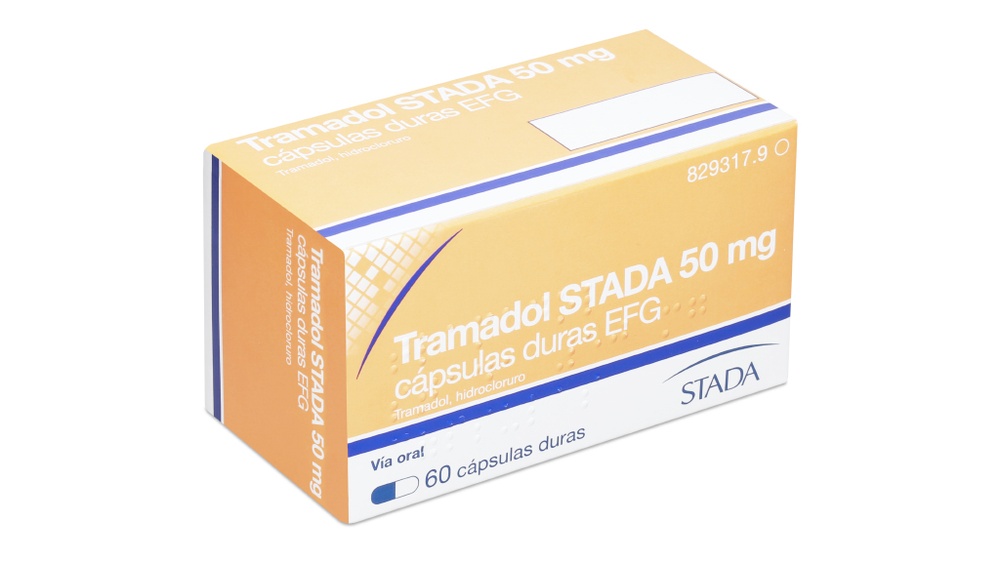

ТРАМАДОЛ СТАДА 50 мг ТВЕРДІ КАПСУЛИ

Запитайте лікаря про рецепт на ТРАМАДОЛ СТАДА 50 мг ТВЕРДІ КАПСУЛИ

Інструкція із застосування ТРАМАДОЛ СТАДА 50 мг ТВЕРДІ КАПСУЛИ
Введення
Опис: інформація для користувача
Трамадол Стада 50 мг тверді капсули EFG
Трамадол, гідрохлорид
Всімістно прочитайте цей листок перед тим, як почати приймати цей препарат, оскільки він містить важливу інформацію для вас.
- Збережіть цей листок, оскільки вам може знадобитися знову його прочитати.
- Якщо у вас є якісь питання, проконсультуйтеся з вашим лікарем або фармацевтом.
- Цей препарат призначений тільки для вас, і не передавайте його іншим людям, навіть якщо вони мають такі самі симптоми, як і ви, оскільки це може їм нашкодити.
- Якщо ви відчуваєте побічні ефекти, проконсультуйтеся з вашим лікарем або фармацевтом, навіть якщо це побічні ефекти, які не перелічені в цьому листку. Див. розділ 4.
Зміст листка
- Що таке Трамадол Стада і для чого він використовується
- Що потрібно знати перед тим, як почати приймати Трамадол Стада
- Як приймати Трамадол Стада
- Можливі побічні ефекти
- Зберігання Трамадол Стада
- Зміст упаковки та додаткова інформація
1. Що таке Трамадол Стада і для чого він використовується
Трамадол Стада призначений для лікування болю середньої та сильної інтенсивності.
2. Що потрібно знати перед тим, як почати приймати Трамадол Стада
Не приймайте Трамадол Стада:
- якщо ви алергічні на активну речовину або на будь-який інший компонент цього препарату (перелічені в розділі 6).
- у випадках гострих отруєнь, спричинених алкоголем, снодійними засобами, анальгетиками або іншими психотропними засобами (засобами, які діють на настрій і емоції);
- якщо ви приймаєте інгібітори моноаміноксидази (ІМАО), певний тип препаратів для лікування депресії, або якщо ви приймали їх протягом останніх 14 днів перед лікуванням трамадолом (див. «Прийом Трамадол Стада з іншими препаратами»);
- якщо ви страждаєте на епілепсію, яка не контролюється лікуванням;
- для лікування синдрому абстиненції.
Попередження та застереження
Проконсультуйтеся з вашим лікарем або фармацевтом перед тим, як почати приймати Трамадол Стада:
- якщо ви вважаєте, що ви залежні від інших сильних анальгетиків (опіоїдів);
- якщо у вас знижений рівень свідомості (якщо ви вважаєте, що можете втратити свідомість);
- якщо ви знаходитеся в стані шоку (одним із ознак цього стану може бути холодний пот);
- якщо у вас підвищений внутрішньочерепний тиск (наприклад, після черепно-мозкової травми
- або захворювань, які впливають на мозок);
- якщо у вас труднощі з диханням;
- якщо ви епілептик або страждаєте на конвульсії, оскільки ризик виникнення конвульсій може збільшитися;
- якщо у вас є деякі захворювання печінки або нирок.
- трамадол повинен бути використаний з обережністю, якщо у вас є гостра порфірія.
- якщо ви страждаєте на депресію та приймаєте антидепресанти, оскільки деякі з них можуть взаємодіяти з трамадолом (див. «Інші препарати та Трамадол Стада»).
Було повідомлено про конвульсії у пацієнтів, які приймали трамадол у рекомендованій дозі. Ризик може збільшитися, коли доза трамадолу перевищує максимальну добову рекомендовану дозу (400 мг).
Трамадол перетворюється в печінці за допомогою ферменту. Деякі люди мають варіацію цього ферменту, і це може вплинути на кожного по-різному. У деяких людей може не бути достатнього полегшення болю, тоді як інші люди мають більший ризик виникнення серйозних побічних ефектів. Якщо ви помітите будь-які з цих побічних ефектів, ви повинні припинити приймати цей препарат і проконсультуватися з лікарем негайно: повільне або поверхневе дихання, сплутаність свідомості, сонливість, звуження зіниць, загальне нездоров'я або нудота, запор, відсутність апетиту.
Проконсультуйтеся з лікарем, навіть якщо будь-яка з вищезазначених обставин колись траплялася з вами.
Толерантність, залежність і звикання
Цей препарат містить трамадол, який є опіоїдним препаратом. Повторне використання опіоїдів може зробити препарат менш ефективним (організм звикає до нього, що відомо як фармакологічна толерантність). Повторне використання Трамадол Стада також може спричинити залежність, зловживання та звикання, що може привести до потенційно смертельної передозування. Ризик цих побічних ефектів може бути більшим при вищій дозі та тривалому використанні.
Залежність або звикання можуть спричинити відчуття відсутності контролю над кількістю препарату, який ви повинні приймати, або над частотою прийому.
Ризик залежності або звикання варіюється від людини до людини. Ризик стати залежним
або звикнутим до Трамадол Стада може бути більшим, якщо:
- Ви або будь-хто з вашої сім'ї мали досвід зловживання алкоголем або залежності від нього, препаратів, що викликають залежність, або незаконних речовин («залежність»).
- Ви курите.
- Ви мали проблеми з настроєм (депресія, тривога або розлад особистості) або проходили лікування у психіатра через інші психічні захворювання.
- Якщо ви помітите будь-які з цих симптомів під час прийому Трамадол Стада, це може бути ознакою залежності або звикання:
- Вам потрібно приймати препарат триваліший час, ніж рекомендовано лікарем.
- Вам потрібно приймати вищу дозу, ніж рекомендовано.
- Ви використовуєте препарат за іншими причинами, ніж ті, які призначені лікарем, наприклад, «щоб бути спокійним» або «щоб допомогти заснути».
- Ви зробили повторні спроби припинити приймати препарат або контролювати його прийом, але вони були невдалими.
- Ви відчуваєте нездоров'я, коли припиняєте приймати препарат, і відчуваєте себе краще, коли знову починаєте його приймати («ефекти відміни»).
Якщо ви помітите будь-які з цих ознак, проконсультуйтеся з лікарем, щоб визначити найкращий варіант лікування для вас, коли потрібно припинити приймати препарат і як це зробити безпечно (див. розділ 3, якщо ви припиняєте лікування Трамадол Стада).
Розлади дихання, пов'язані зі сном
Трамадол може спричинити розлади дихання, пов'язані зі сном, такі як апное сну (перерви в диханні під час сну) та гіпоксемія, пов'язана зі сном (низький рівень кисню в крові). Серед симптомів можуть бути перерви в диханні під час сну, нічні пробудження через нестачу повітря, труднощі з підтриманням сну або надмірна сонливість протягом дня. Якщо ви або хтось інший помітить ці симптоми, зверніться до лікаря. Можливо, лікар вирішить зменшити дозу.
Поговоріть з лікарем, фармацевтом або медсестрою, якщо ви відчуваєте будь-які з цих симптомів під час прийому трамадолу:
Надмірна втома, відсутність апетиту, сильний біль у животі, нудота, блювота або низький тиск. Це можуть бути ознаки недостатньої функції наднирників (низький рівень кортизолу). Якщо ви маєте ці симптоми, зверніться до лікаря, який вирішить, чи потрібно вам приймати гормональні добавки.
Існує низький ризик того, що ви відчуєте серотоніновий синдром, який може виникнути після прийому трамадолу в поєднанні з певними антидепресантами або трамадолом у монотерапії. Негайно зверніться до лікаря, якщо ви відчуваєте будь-які з цих симптомів, пов'язаних з цим серйозним синдромом (див. розділ 4 «Можливі побічні ефекти»).
Діти та підлітки
Використання в дітей з проблемами дихання
Не рекомендується використовувати трамадол у дітей з проблемами дихання, оскільки симптоми токсичності трамадолу можуть погіршитися в цих дітей.
Інші препарати та Трамадол Стада
Повідомте лікаря або фармацевта, якщо ви приймаєте, нещодавно приймали або можете приймати будь-які інші препарати.
Необхідно уникати одночасного лікування трамадолом з інгібіторами моноаміноксидази (ІМАО), певним типом препаратів для лікування депресії.
Ефект, а також тривалість полегшення болю, яке викликає трамадол, можуть бути зменшені, якщо ви приймаєте препарати, які містять:
- Карбамазепін (для лікування конвульсій).
- Ондансетрон (для профілактики нудоти).
Лікар призначить вам, чи потрібно приймати трамадол, і в якій дозі.
Одночасне використання трамадолу з седативними препаратами, такими як бензодіазепіни або пов'язані з ними препарати, збільшує ризик седації, депресії дихання, коми або навіть смерті. Через це одночасне використання повинно бути розглянуто лише тоді, коли немає інших варіантів лікування. Однак, якщо лікар призначить вам трамадол разом з седативними препаратами, дозу та тривалість лікування необхідно обмежити.
Повідомте лікаря про всі седативні препарати, які ви приймаєте, і слідуйте рекомендаціям щодо дозування лікаря. Це може бути корисно повідомити друзям або родичам, щоб вони знали про ознаки та симптоми, зазначені вище. Зверніться до лікаря, якщо ви відчуваєте ці симптоми.
Ризик побічних ефектів збільшується,
- якщо ви приймаєте трамадол одночасно з седативними засобами, снодійними засобами, іншими анальгетиками, такими як морфін і кодеїн (даже якщо вони використовуються для лікування кашлю), і алкоголем. У цих випадках ви можете відчувати сонливість або головокружіння. Якщо це відбувається, проконсультуйтеся з лікарем;
- якщо ви приймаєте препарати, які можуть спричинити конвульсії, такі як певні антидепресанти або антипсихотичні засоби. Ризик конвульсій збільшується, якщо ви приймаєте трамадол одночасно з цими препаратами. Лікар призначить вам, чи підходить трамадол для вас.
- якщо ви приймаєте антидепресанти, трамадол може взаємодіяти з цими препаратами, і ви можете відчувати серотоніновий синдром (див. розділ 4 «Можливі побічні ефекти»). якщо ви приймаєте антикоагулянти, такі як аценокумарол (Синтром?), оскільки це може збільшити ризик кровотеч.
- якщо ви приймаєте препарати, які можуть збільшити накопичення трамадолу та його побічні ефекти (наприклад, ритонавір, хінідин, пароксетин, флуоксетин, сертралін, амітріптилін, ізоніазид, кетоконазол та еритроміцин).
- якщо ви приймаєте габапентин або прегабалін для лікування епілепсії або болю, пов'язаного з проблемами нервів (нейропатичний біль).
Прийом Трамадол Стада з їжею та алкоголем
Не вживайте алкоголь під час лікування трамадолом, оскільки алкоголь може посилити ефекти трамадолу. Їжа не впливає на ефект трамадолу.
Вагітність, лактація та фертильність
Якщо ви вагітні або годуєте грудьми, вважаєте, що можете бути вагітні або плануєте вагітність, проконсультуйтеся з лікарем або фармацевтом перед тим, як використовувати цей препарат.
Існує дуже мало інформації про безпеку трамадолу у вагітних жінок. Тому не слід використовувати трамадол, якщо ви вагітні.
Хронічне лікування під час вагітності може спричинити синдром відміни у дитини після пологів.
Трамадол виділяється в грудне молоко. Через це не слід приймати трамадол більше одного разу під час годування грудьми, або якщо ви приймаєте трамадол більше одного разу, ви повинні припинити годування грудьми.
На основі досвіду у людей не рекомендується, щоб трамадол впливав на фертильність чоловіків та жінок.
Водіння транспортних засобів та використання машин
Спитайте лікаря, чи можете ви водити транспортні засоби або використовувати машини під час лікування трамадолом. Це важливо, щоб спостерігати, як цей препарат впливає на вас. Не водьте транспортні засоби та не використовуйте машини, якщо ви відчуваєте сонливість, головокружіння, маєте розмитий зір або бачите подвійне, або маєте труднощі з концентрацією уваги. Будьте особливо обережні на початку лікування, після збільшення дози, після зміни форми препарату та/або при одночасному прийомі з іншими препаратами.
Трамадол Стада містить лактозу та натрій
Цей препарат містить лактозу. Якщо лікар призначив вам дієту з обмеженням певних цукрів, проконсультуйтеся з ним перед тим, як приймати цей препарат.
Цей препарат містить менше 1 ммоль натрію (23 мг) на капсулу; це означає, що він «практично не містить натрію».
3. Як приймати Трамадол Стада
Слідуйте точно інструкціям щодо прийому цього препарату, які призначив лікар. У разі сумнівів проконсультуйтеся з лікарем або фармацевтом знову.
Перед тим, як почати лікування, і регулярно під час нього лікар також пояснить вам, чого можна очікувати від використання Трамадол Стада, коли та на який час потрібно його приймати, коли потрібно звернутися до лікаря та коли потрібно припинити прийом (див. також розділ 2).
Дозу необхідно коригувати залежно від інтенсивності болю та індивідуальної чутливості. Зазвичай потрібно використовувати мінімальну дозу, яка забезпечує полегшення болю. Не приймайте більше 400 мг гідрохлориду трамадолу на добу, якщо тільки лікар не призначив інакше.
Якщо тільки лікар не дав вам інших інструкцій, рекомендована доза становить:
Дорослі та підлітки старші 12 років
Зазвичай початкова доза становить 1 або 2 капсули трамадолу (що відповідає 50-100 мг трамадолу).
Ефект може тривати від 4 до 6 годин, залежно від болю.
Використання в дітей
Трамадол не рекомендується для дітей молодших 12 років.
Пацієнти похилого віку
У пацієнтів похилого віку (старших 75 років) виділення трамадолу може бути повільним. Якщо це ваш випадок, лікар може рекомендувати збільшити інтервали між прийомами.
Пацієнти з порушеннями функції печінки або нирок/пацієнти на діалізі
Якщо у вас є серйозні захворювання печінки або нирок, лікування трамадолом не рекомендується. Якщо у вас є помірні порушення функції печінки або нирок, лікар може рекомендувати збільшити інтервали між прийомами.
Як і коли потрібно приймати Трамадол Стада?
Капсули трамадолу приймаються перорально.
Проглотіть капсули цілі, не розбиваючи та не жуючи, з достатньою кількістю рідини.
Ви можете приймати капсули як на пустий шлунок, так і з їжею.
Як довго потрібно приймати Трамадол Стада?
Цей препарат не повинен прийматися довше, ніж абсолютно необхідно. Якщо ви потребуєте тривалого лікування, лікар буде контролювати вас на коротких інтервалах та регулярно (якщо потрібно з перервами в лікуванні), щоб визначити, чи потрібно продовжувати лікування цим препаратом та в якій дозі.
Якщо ви вважаєте, що ефект цього препарату надто сильний або надто слабкий, повідомте лікаря або фармацевта.
Якщо ви прийняли більше Трамадол Стада, ніж потрібно
Якщо ви прийняли додаткову дозу випадково, це зазвичай не має негативних ефектів. Ви повинні прийняти наступну дозу так, як це було призначено.
Після прийому дуже високих доз трамадолу можуть виникнути звуження зіниць, нудота, зниження артеріального тиску, збільшення частоти серцевих скорочень, колапс, зниження рівня свідомості до коми (глибока безсвідомість), конвульсії та труднощі з диханням, які можуть призвести до зупинки дихання. У цьому випадку негайно зверніться до лікаря!
У разі передозування або випадкового прийому зверніться негайно до медичного центру або зателефонуйте до служби токсикологічної інформації, телефон 91 562 04 20, повідомивши назву препарату та кількість, яку ви прийняли. Рекомендується взяти з собою листок препарату до медичного працівника.
Якщо ви забули прийняти Трамадол Стада
Якщо ви забули прийняти препарат, ймовірно, що біль знову з'явиться. Не приймайте подвійну дозу, щоб компенсувати забуті дози, просто продовжуйте приймати трамадол так, як ви робили це раніше.
Якщо ви припиняєте лікування Трамадол Стада
Якщо ви припиняєте лікування цим препаратом занадто рано, ймовірно, що біль знову з'явиться. Якщо ви хочете припинити лікування через побічні ефекти, проконсультуйтеся з лікарем.
Не слід припиняти приймати цей препарат раптово, якщо тільки лікар не призначив інакше. Якщо ви хочете припинити приймати свій препарат, спочатку проконсультуйтеся з лікарем, особливо якщо ви приймали його тривалий час. Лікар повідомить вам, коли та як припинити лікування, що можна зробити шляхом поступового зменшення дози, щоб зменшити ймовірність виникнення непотрібних побічних ефектів (симптомів відміни).
Зазвичай не трапляються побічні ефекти, коли лікування трамадолом припиняється. Однак у рідких випадках люди, які приймали трамадол тривалий час, можуть відчувати себе погано, коли раптово припиняють лікування. Вони можуть відчувати агресивність, тривогу, нервозність або тремор. Вони можуть бути надто активними, мати труднощі з сном або проблеми з травленням та кишковим рухом. Дуже рідко люди можуть відчувати панічні атаки, галюцинації, незвичайні відчуття, такі як свербіж, оніміння, поколювання та звук у вухах (акуфени). Дуже рідко були виявлені інші незвичайні симптоми з боку нервової системи, такі як сплутаність свідомості, марення, зміна сприйняття особистості (деперсоналізація) та зміна сприйняття реальності (дереалізація) та марення переслідування (параноя). Якщо ви відчуваєте будь-які з цих симптомів після припинення лікування трамадолом, проконсультуйтеся з лікарем.
Якщо у вас є будь-які інші питання щодо використання цього препарату, проконсультуйтеся з лікарем або фармацевтом.
4. Можливі побічні ефекти
Як і всі ліки, цей препарат може викликати побічні ефекти, хоча не всі люди їх відчувають.
Ви повинні негайно звернутися до лікаря, якщо у вас з'являються симптоми алергічної реакції, такі як набряк обличчя, язика та/або горла і/або труднощі з ковтанням та висипка разом з труднощами дихання.
Найбільш часті побічні ефекти під час лікування трамадолом - це нудота та головокружіння, які трапляються у більш ніж 1 з 10 осіб.
Дуже часті: можуть впливати на більш ніж 1 з 10 осіб
- Головокружіння.
- Нудота.
Часті: можуть впливати до 1 з 10 осіб
- Головний біль та оніміння.
- Втома.
- Воміта, запор та сухість у роті.
- Потіння (гіпергідроз).
Рідкі: можуть впливати до 1 з 100 осіб
- Ефекти на серце та кровообіг (сильні серцеві удари та швидкі серцеві удари, відчуття головокружіння або колапсу). Ці побічні ефекти можуть виникнути особливо у пацієнтів, які перебувають у вертикальному положенні або які здійснюють фізичні зусилля.
- Бажання блювати (аркади), нездужання шлунково-кишкового тракту (наприклад, відчуття переповнення, важкості), діарея.
- Алергічні реакції шкіри (наприклад, свербіж, висипка).
Рідкісні: можуть впливати до 1 з 1000 осіб
- Алергічні реакції (наприклад, труднощі дихання, свистіння, набряк шкіри) та шок (раптове порушення кровообігу) трапляються у дуже рідкісних випадках.
- Повільний серцевий ритм.
- Збільшений артеріальний тиск.
- Аномальні відчуття (наприклад, свербіж, оніміння, поколювання), тремор, епілептичні напади, м'язові спазми, некоординовані рухи, тимчасова втрата свідомості (синкоп), розлади мови.
- Епілептичні напади відбуваються в основному після прийому високих доз трамадолу або коли приймається одночасно з іншими препаратами, які можуть викликати їх.
- Зміни апетиту.
- Галюцинації, стан плутанини, порушення сну, делірій, тривога та кошмари.
- Можуть виникнути психологічні порушення після лікування трамадолом. Їх інтенсивність та характер можуть варіюватися (залежно від особистості пацієнта та тривалості лікування). Вони можуть проявлятися у вигляді змін настрою (зазвичай ейфорія, іноді раздражливість), змін у діяльності (зазвичай зменшення та іноді збільшення) та зниження когнітивної та сенсорної сприйняття (порушення відчуттів та сприйняття, які можуть привести до помилок у судженні).
- Може викликати залежність від препарату. Якщо трамадол використовується протягом тривалого часу, він може викликати залежність, хоча ризик дуже низький. Коли лікування припиняється раптово, може виникнути синдром відміни (див. "Якщо ви припиняєте лікування трамадолом").
- Затьмарене зір, надмірне розширення зіниць (мідріаз), звуження зіниць (міоз).
- Повільне дихання, нестача повітря (диспное).
- Було повідомлено про випадки погіршення астми, однак не встановлено, чи були вони викликані трамадолом. Якщо перевищуються рекомендовані дози або якщо приймається одночасно з іншими препаратами, які пригнічують функцію мозку, може виникнути зниження частоти дихання.
- М'язова слабкість.
- Труднощі або біль під час сечовипускання, менша кількість сечі, ніж зазвичай (дисурія).
Дуже рідкісні: можуть впливати до 1 з 10 000 осіб
- Збільшення рівня печінкових ферментів.
Частота невідома: частота, яку не можна оцінити на основі наявних даних
- Зниження рівня цукру в крові.
- Гіпо
Частота невизначена (не може бути оцінена на основі наявних даних)
Серотоніновий синдром, який може проявлятися змінами стану свідомості (наприклад, агітацією, галюцинаціями, комою), та іншими ефектами, такими як гарячка, збільшення частоти серцевих ударів, нестабільний артеріальний тиск, м'язові спазми, ригідність м'язів, порушення координації та/або шлунково-кишкові симптоми (наприклад, нудота, блювання, діарея) (див. розділ 2 "Що вам потрібно знати перед початком прийому трамадолу").
Звіт про побічні ефекти:
Якщо ви відчуваєте будь-які побічні ефекти, зверніться до свого лікаря або фармацевта, навіть якщо це можливі побічні ефекти, які не вказані в цьому листку. Ви також можете повідомити про них безпосередньо через Іспанську систему фармакологічного нагляду за лікарськими засобами для людини: https://www.notificaram.es. Завдяки повідомленню про побічні ефекти ви можете допомогти надати більше інформації про безпеку цього препарату.
5. Зберігання трамадолу
Тримайте цей препарат поза зоною досяжності дітей.
Зберігайте цей препарат у безпечному місці, захищеному від доступу інших осіб. Цей препарат може викликати серйозні ушкодження та навіть бути смертельним для осіб, яким він не призначений.
Цьому препарату не потрібні спеціальні умови зберігання.
Не використовуйте цей препарат після закінчення терміну придатності, вказаного на упаковці та блистерній упаковці після CAD. Термін придатності - останній день місяця, вказаного на упаковці.
Лікарські засоби не повинні викидатися у водопровідні труби чи сміття. Відкладайте упаковки та лікарські засоби, які вам не потрібні, у спеціальний пункт збору в аптеці. У разі сумнівів запитайте у свого фармацевта, як позбутися упаковок та лікарських засобів, які вам не потрібні. Таким чином ви допоможете захистити навколишнє середовище.
6. Зміст упаковки та додаткова інформація
Склад трамадолу
- Активний інгредієнт - гідрохлорид трамадолу. Кожна капсула містить 50 мг гідрохлориду трамадолу.
- Інші компоненти - лактоза моногідрат, мікрокристалічна целюлоза, карбоксиметиламідон натрію (тип А), стеарат магнію, повідон К 30.
Склад оболонки капсули: желатина та діоксид титану
Вигляд продукту та зміст упаковки
Трамадол - капсули з твердої желатини. Він випускається в упаковках по 20, 60 та 500 капсул.
Можливо, що тільки деякі розміри упаковок будуть реалізовані.
Власник дозволу на реалізацію та відповідальна особа за виробництво
Власник дозволу на реалізацію
Лабораторія STADA, С.L.
Фредерік Момпу, 5
08960 Сант Жуст Десверн (Барселона)
Іспанія
Відповідальна особа за виробництво
Toll Manufacturing Services, С.L.
Арагонеси, 2
28108 Алькобендас (Мадрид)
Іспанія
Дата останнього перегляду цього листка:травень 2024
Детальна та актуальна інформація про цей препарат доступна на сайті Іспанського агентства лікарських засобів та медичних продуктів (AEMPS) http://www.aemps.gob.es/

Скільки коштує ТРАМАДОЛ СТАДА 50 мг ТВЕРДІ КАПСУЛИ в Іспанії у 2025 році?
ТРАМАДОЛ СТАДА 50 мг ТВЕРДІ КАПСУЛИ коштує в середньому 2.5 євро у листопад, 2025 році. Ціна може змінюватися залежно від регіону, аптеки та наявності рецепта. Рекомендуємо перевіряти актуальну вартість у місцевих аптеках або через онлайн-сервіси.
- Країна реєстрації
- Середня ціна в аптеках2.5 EUR
- Діючі речовини
- Потрібен рецептТак
- Виробник
- Інформація є довідковою і не є медичною порадою. Перед прийомом будь-яких препаратів обов'язково проконсультуйтеся з лікарем. Oladoctor не несе відповідальності за медичні рішення, прийняті на основі цього контенту.
- Альтернативи до ТРАМАДОЛ СТАДА 50 мг ТВЕРДІ КАПСУЛИФорма випуску: ОРАЛЬНИЙ РОЗЧИН/СУСПЕНЗІЯ, 100 мг/млДіючі речовини: tramadolВиробник: Grünenthal Pharma S.A.Потрібен рецептФорма випуску: РОЗЧИН ДЛЯ ІН'ЄКЦІЙ, 100 мгДіючі речовини: tramadolВиробник: Grünenthal Pharma S.A.Потрібен рецептФорма випуску: КАПСУЛА, 50 мгДіючі речовини: tramadolВиробник: Grünenthal Pharma S.A.Потрібен рецепт
Аналоги ТРАМАДОЛ СТАДА 50 мг ТВЕРДІ КАПСУЛИ в інших країнах
Найкращі аналоги з тією самою діючою речовиною та терапевтичним ефектом.
Аналог ТРАМАДОЛ СТАДА 50 мг ТВЕРДІ КАПСУЛИ у Польща
Аналог ТРАМАДОЛ СТАДА 50 мг ТВЕРДІ КАПСУЛИ у Україна
Лікарі онлайн щодо ТРАМАДОЛ СТАДА 50 мг ТВЕРДІ КАПСУЛИ
Консультація щодо дозування, побічних ефектів, взаємодій, протипоказань та поновлення рецепта на ТРАМАДОЛ СТАДА 50 мг ТВЕРДІ КАПСУЛИ – за рішенням лікаря та згідно з місцевими правилами.














